|
|
|
Sort Order |
|
|
|
Items / Page
|
|
|
|
|
|
|
| Srl | Item |
| 1 |
ID:
168813


|
|
|
|
|
| Summary/Abstract |
This paper aims to study the history and significance of Vibhishana in Sri Lanka, an important character in the Ramayana, one of the two most renowned classical epics originating from India that became popular in South and Southeast Asia. Although the protagonist of the Ramayana, Rama, along with his spouse Sita and ardent ally Hanuman, are venerated throughout Hindu and Buddhist South and Southeast Asia, a Vibhishana cult is only found in Sri Lanka. How this came about is the central question investigated in this paper. Towards this end, historical and cultural factors specific to Sri Lanka are interrogated to tease out the circumstances that have contributed to Vibhishana’s divinity. Representations of Vibhishana in literature, art and temple worship are scrutinised to problematise Vibhishana’s significance within the Buddhist religious cosmos and his continued relevance even during the recent emergence of the cult of Ravana, his mighty older brother in the Ramayana.
|
|
|
|
|
|
|
|
|
|
|
|
|
|
|
|
| 2 |
ID:
168807
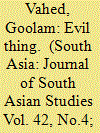

|
|
|
|
|
| Summary/Abstract |
Between 1860 and 1911, 152,184 Indian indentured workers went to the then British colony of Natal to work primarily on the sugar plantations. They were followed by free Indian migrants. White settlers felt threatened by a settled Indian population and passed legislation to curb their immigration, trading, employment and residence rights. The struggle of Indians against this racist legislation was spearheaded by Mohandas Karamchand Gandhi. The most contentious issues surrounding Gandhi’s South African stay between 1893 and 1914 are his allegedly racist attitudes towards Africans and his neglect of indentured migrants and their descendants. This article examines Gandhi’s attitude to, and relationship with, the indentured. While most academic studies have argued that Gandhi was oblivious to them until 1913, this article presents a nuanced picture, drawing on aspects of historical archives that have not yet been fully drawn upon, or re-reading those that have been consulted previously. It shows that Gandhi’s views underwent an observable transformation during the time that he was in South Africa, to the point that he came to describe the system of indenture as ‘an evil thing’. However, his reasons for wanting an end to the system were multiple and complex, relating not just to the plight of the indentured, but also the utility of ending indenture for non-indentured Indians.
|
|
|
|
|
|
|
|
|
|
|
|
|
|
|
|
| 3 |
ID:
168812
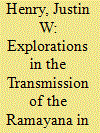

|
|
|
|
|
| Summary/Abstract |
This essay explores the identification of the island of Sri Lanka with the ‘Lankapura’ of Ramayana literary fame, tracing the transmission of the mythical geography of the epic from late medieval South India to Sri Lankan Tamil temple literature. The invading Cholas of the tenth century were the first to identify Sri Lanka as the ‘Lanka’ of the Ramayana, a geographical equivalence maintained by the Arya Cakravarti rulers who dubbed themselves ‘guardians of Rama’s bridge’ (cētu kāvalan). I highlight the uniquely sympathetic treatment of Ravana by the Hindus of eastern Sri Lanka, and explore the likelihood that Tamil impressions of Ravana impacted his appearance in Sinhala Buddhist literature from the fifteenth century onwards.
|
|
|
|
|
|
|
|
|
|
|
|
|
|
|
|
| 4 |
ID:
168811


|
|
|
|
|
| Summary/Abstract |
The five articles which make up this special issue of South Asia explore the role of the Ramayana in Sri Lankan art, literature, religious ritual and political discourse in shaping Sinhala Buddhist and Tamil Saiva perceptions of the island’s distant past. Contributors work to answer the question as to when and how Sri Lanka came to be equated with the mythic ‘Lankapura’ of Valmiki’s epic, exploring both positive and negative portrayals of Ravana (ruler of Lanka antagonist of the Ramayana) in Sinhala and Tamil literature from the late medieval period to the present day. Authors work to account for the politicisation and historicisation of the Ramayana in twenty-first century Sri Lanka (including similarities to and differences from the contemporary Indian situation), along with the appropriation of Ravana as a Sinhala Buddhist cultural hero, and the incorporation of Vibhishana as a ‘guardian deity’ in the Sinhala Buddhist pantheon.
|
|
|
|
|
|
|
|
|
|
|
|
|
|
|
|
| 5 |
ID:
168814
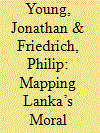

|
|
|
|
|
| Summary/Abstract |
This article analyses the ways in which a little-known Sinhala text called the Ravana Rajavaliya articulates a moral topography of late medieval Sri Lanka. Rather than expressing a kind of all-consuming xenophobia in response to social and cultural difference, the text indexes a set of local political responses to the surge in social mobility occasioned by changing patterns of trans-regional circulation in Sri Lanka’s southwest. We argue that ‘others’ are represented in terms of proximity to a generalised moral order, one which highlights desirable forms of selfhood as instruments for assimilation within an emerging state society.
|
|
|
|
|
|
|
|
|
|
|
|
|
|
|
|
| 6 |
ID:
168808


|
|
|
|
|
| Summary/Abstract |
The circumstances of Tibetan refugees in India in the 1960s attracted international recognition. The question of their asylum provoked domestic debate about India’s relations with China and had implications for India’s vision of non-alignment, particularly regarding how human rights and self-determination would be brought together in the changing post-colonial world. Ultimately, the Indian government led by Prime Minister Jawaharlal Nehru focused on the Indian state’s right to grant Tibetans asylum and assistance, with limited involvement from the international community. Public opinion in India called for the refugees’ right to self-determination in Tibet. Simultaneously, the Nehruvian vision of non-alignment was undergoing a change from its immediate post-colonial form. The Indian government tried to draw a clear line between those displaced by India’s own decolonisation and by Partition, and a crisis that was a thorn in the side of Sino-Indian bilateral relations in the bipolar world of the Cold War. The 1960s can therefore be seen as India’s reframing of the term ‘refugee’ to reflect its own interests domestically and internationally.
|
|
|
|
|
|
|
|
|
|
|
|
|
|
|
|
| 7 |
ID:
168810


|
|
|
|
|
| Summary/Abstract |
The concept of shauq or shauk connotes a passionate interest, galvanising individuals across South Asia to devote time, energy and resources beyond their expected social roles and towards particular chosen activities. This essay explores explications of shauq encountered in the course of field research on men’s pigeon flying in Pakistan and village women’s singing in India, situating insights from the field amid available scholarly literature on shauq. Shauq can make fieldwork the arena for a spirited transmission of knowledge. We explore how people express the well-being emerging from shauq, the sociality of shared interest, and why shauq can be dangerous.
|
|
|
|
|
|
|
|
|
|
|
|
|
|
|
|
| 8 |
ID:
168815


|
|
|
|
|
| Summary/Abstract |
By examining the public discourse on Ravana that has been widespread among Sinhalese in the recent past, this paper suggests that the Sinhala nation is perhaps on the verge of being redefined. In comparison to the origin story of the Sinhalese that remained seriously unchallenged till the end of the twentieth century, in which the Sinhalese were considered the descendants of the Aryan prince Vijaya who arrived on the island around 2,500 years ago, this new narrative identifies the yakkha king Ravana as the originator of the Sinhala nation by going further back into the past. The paper also attempts to explain why this surge of interest in Ravana is taking place at this particular moment and not earlier.
|
|
|
|
|
|
|
|
|
|
|
|
|
|
|
|
| 9 |
ID:
168816
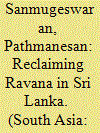

|
|
|
|
|
| Summary/Abstract |
This paper considers the appropriation of Ravana, the demon-king antagonist of the famed Ramayana epic, as a Sinhala Buddhist cultural hero in the context of twenty-first-century, post-war Sri Lanka. We highlight the irony of the recent Buddhist appropriation of Ravana as a signifier of indigeneity and sovereignty, given that he has already been employed in this capacity in the Tamil Hindu context for nearly a century. We note several convergences between the ‘Sinhala Ravana’ phenomenon and its Tamil counter-narrative, including a shared archive of textual material invoked as evidence, the introduction of alleged physical evidence as proof of Ravana’s historicity, and a sympathetic outlook on Ravana’s character, emphasising his qualities as a learned and righteous king.
|
|
|
|
|
|
|
|
|
|
|
|
|
|
|
|
| 10 |
ID:
168805
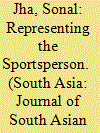

|
|
|
|
|
| Summary/Abstract |
This paper follows a call for a new direction for sports studies in India, orienting it towards the field of cultural studies. It focuses on the representation of the figure of the sports celebrity in television advertising in India from the 1980s to the present, establishing the various kinds of representations of this figure, and proceeds to a historical analysis of the changes that these representations have undergone over time. It also argues that the evolution of the celebrity sportsperson, and the meanings attached to this figure, can help in tracing larger changes in sports discourse in India.
|
|
|
|
|
|
|
|
|
|
|
|
|
|
|
|
| 11 |
ID:
168806
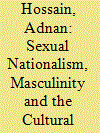

|
|
|
|
|
| Summary/Abstract |
Highlighting the way cricket has become a site of a new nationalist masculinity in post-colonial Bangladesh, this paper examines the eruption of a recent controversy about a Bangladeshi cricketer’s sexual entanglement with a movie actress just before the ICC (International Cricket Council) World Cup in 2015. The long-running racial interpretation of Bangladeshis as being of short stature and frail in the popular Indian and Pakistani media has led Bangladeshi cricket supporters to view this athlete’s sexual aggression, despite charges of rape and sexual harassment, as an expression of Bangladeshi masculinity. The problem is that in positing this athlete as a counterpoise to the dominant Indian and Pakistani cricket nationalism, the nationalist resurgence in Bangladesh produced an aggressively heterosexual and masculinist politics that relegated women to a commodity in the formation of a cricket-based nationalism. I argue that the collective cultural complicity with the making of this new masculinity is not just the product of a Bangladeshi patriarchy, but is rooted in a fear of a putative emasculation in the field of cricket by other nations.
|
|
|
|
|
|
|
|
|
|
|
|
|
|
|
|
| 12 |
ID:
168809


|
|
|
|
|
| Summary/Abstract |
The dominant paradigm in scholarship on death penalty law in India is doctrinal and empirical. There is an equally indispensable need for a third approach that focuses on the rhetoric of and in death penalty judgements. In the first part of the paper I argue why such an approach is necessary, and in the second part I instantiate this by a close reading of narrative techniques and rhetorical devices deployed in two recent Supreme Court judgements. I show the use of antirrhetic speech, ekphrasis and the ‘reality effect’ woven into the narrative of the taboo on incest, peopled with characters such as ‘diabolical monsters’ plotting ‘sinister designs’. Embedded in these narratives are judges who see themselves as reconstituting a community on the verge of breakdown. In this circular operation, monsters are linguistically created, and the monstrosity of the criminal is then used as a justification for death. Yet such a monster cannot be a wholly non-human figure because intent is necessary for fixing legal responsibility.
|
|
|
|
|
|
|
|
|
|
|
|
|
|
|
|
|
|
|
|
|